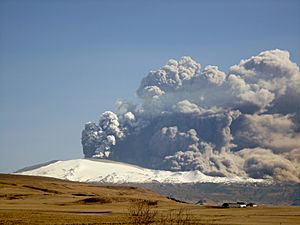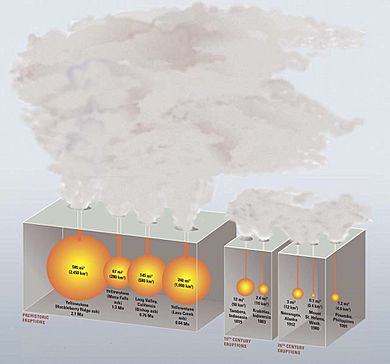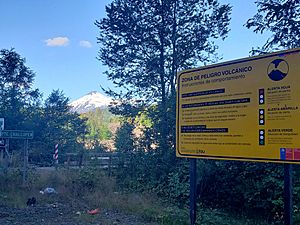Volcanic hazards facts for kids
A volcanic hazard is the chance that a volcano will erupt or cause other dangerous events in a certain area and time. The danger from a volcanic hazard depends on how close people or important things are to the volcano. It also depends on how easily they can be harmed.
Contents
- Lava Flows: Slow but Destructive Rivers of Rock
- Pyroclastic Materials and Flows: Fast and Fiery Dangers
- Mudflows, Floods, and Avalanches: Water and Rock Gone Wild
- Volcanic Gases: Invisible Dangers
- Earthquakes Near Volcanoes: Shaking the Ground
- Examples of Volcanic Hazards Throughout History
- Monitoring and Mitigation: Watching and Preparing
- See also
Lava Flows: Slow but Destructive Rivers of Rock
Different types of flowing lava can create various dangers. Pahoehoe lava is smooth and looks like ropes. Aa lava is rough and blocky. Lava flows usually move downhill, filling valleys and low areas. These hot flows can bury roads, farms, and homes. They can destroy cars and buildings. While lava flows are dangerous, they move slowly. This gives people time to get out of the way and evacuate safely. To stay safe, people should avoid building homes in valleys or low spots near a volcano.
Pyroclastic Materials and Flows: Fast and Fiery Dangers
Tephra is a general word for all the pieces of rock and ash shot out of a volcano during an eruption. These pieces come in different sizes:
- Dust: Smaller than 1/8 millimeter (like fine powder).
- Ash: 1/8 to 2 millimeters (like sand).
- Cinders: 2 to 64 millimeters (like small pebbles).
- Bombs and blocks: Larger than 64 millimeters (can be as big as cars!).
Each size of tephra causes different problems. Dust and ash can cover cars and homes. They can make cars stop working by getting into the engine. Heavy ash can pile up on roofs, making houses collapse. Breathing in ash and dust can also cause long-term breathing problems. Cinders are hot, flaming pieces that can start fires in homes and forests. Volcanic bombs and blocks are large rocks that can fly thousands of feet in the air. They can land miles away, hitting and destroying anything in their path.
A pyroclastic flow is a super-fast and extremely hot cloud of gas and tephra. It can rush down the side of a volcano at speeds up to 700 kilometers per hour (about 435 miles per hour). These flows can be as hot as 1000°C (1832°F). They are one of the most dangerous volcanic hazards.
How Volcanic Ash Affects Air Travel
Ash clouds from eruptions are very dangerous for airplanes, especially jet aircraft. The tiny ash particles can melt in the hot jet engines. This melted ash then sticks to the engine blades, changing their shape and stopping them from working.
This problem became clear after eruptions like Galunggung in Indonesia in 1982 and Mount Redoubt in Alaska in 1989. To help, nine Volcanic Ash Advisory Centers were created around the world. They watch ash clouds and warn pilots. The 2010 eruptions of Eyjafjallajökull in Iceland caused huge problems for air travel across Europe.
Mudflows, Floods, and Avalanches: Water and Rock Gone Wild
When volcanic ash and rock mix with water from a nearby river or stream, they can create fast-moving mudflows. These are called lahars. If a lahar contains large rocks and trees, it's called a volcanic debris flow.
Lahars can form right away if a pyroclastic flow hits a river. They can also form later, called secondary lahars. This happens when rain wets the ash and debris already on the ground, making it sticky and causing it to flow downhill. It only takes about 30% water to turn ash into a lahar. Thicker and faster lahars are more dangerous. They can damage buildings, harm wildlife, and sweep away cars. Once caught in a lahar, it's very hard to escape.
Lahars and mudflows can also crowd rivers, forcing the water to flow out and cause floods. The volcanic material can also pollute the water, making it unsafe to drink.
Over time, the debris from eruptions makes the sides of a volcano steeper. Eventually, the slope can become too steep and collapse, causing an avalanche. These avalanches carry rock and debris very far, very quickly. This makes it almost impossible to warn people in time. Avalanches destroy everything in their path, including homes, buildings, and vehicles.
Volcanic Gases: Invisible Dangers
Large volcanic eruptions release gases like water vapor (H2O), carbon dioxide (CO2), sulfur dioxide (SO2), hydrogen chloride (HCl), and hydrogen fluoride (HF). They also release ash into the upper atmosphere.
The sulfur dioxide (SO2) is very important. It turns into tiny sulfuric acid particles called sulfate aerosols. These aerosols can reflect sunlight back into space, which can cool the Earth's lower atmosphere. However, they also absorb heat from Earth, warming the upper atmosphere. Some eruptions have caused the Earth's temperature to drop slightly for a few years. For example, sulfur dioxide from the 1600 eruption of Huaynaputina might have caused a terrible famine in Russia from 1601 to 1603.
Acid Rain from Volcanoes

Sulfate aerosols in the atmosphere can also affect chemicals like chlorine and nitrogen. This can lead to the destruction of ozone (O3), which protects us from harmful sun rays. Most of the hydrogen chloride (HCl) and hydrogen fluoride (HF) gases dissolve in water droplets in the eruption cloud. They quickly fall to the ground as acid rain.
Volcanic gases are a natural source of acid rain. Volcanoes release about 145 million to 255 million tons of carbon dioxide each year. While large eruptions can cool the climate, they also have benefits. Volcanic rocks break down and add nutrients to the soil, making it very fertile for plants and crops. Volcanoes can even create new islands when magma cools and hardens in the water.
Earthquakes Near Volcanoes: Shaking the Ground
Earthquakes can happen because of volcanic activity. These quakes can cause the ground to crack or buildings to fall. There are two main types of volcanic earthquakes:
- Volcano-tectonic earthquakes: These happen when magma (molten rock) moves into or out of the ground. This causes stress changes in the solid rock. They are dangerous because they can cause ground cracks or landslides, destroying things in their path.
- Long-period earthquakes: These occur when magma suddenly pushes into the surrounding rocks. They are often a sign that an eruption is about to happen.
Examples of Volcanic Hazards Throughout History
Ancient Eruptions and Their Impact
About 70,000 years ago, a huge eruption from the supervolcano Lake Toba in Indonesia may have caused a "volcanic winter." Some scientists believe this event had a global impact. It might have killed most humans alive at the time, creating a "population bottleneck" that affected the genes of all humans today.
Volcanic activity is also thought to have caused or helped cause several mass extinctions in Earth's history. For example, the massive eruptions that formed the Siberian Traps about 250 million years ago are believed to be the cause of the "Great Dying." This event killed an estimated 90% of all species on Earth.
Recent Historical Eruptions
The 1815 eruption of Mount Tambora in Indonesia caused strange weather around the world. It led to the "Year Without a Summer" in 1816. Crops failed and animals died in many parts of the Northern Hemisphere. This resulted in one of the worst famines of the 19th century.
The very cold winter of 1740–41, which caused a widespread famine in northern Europe, might also have been caused by a volcanic eruption.
Monitoring and Mitigation: Watching and Preparing
Many volcanoes around the world are not watched closely. In 1995, experts John Ewert and Ed Miller noted that less than a quarter of historically active volcanoes were monitored. Only 24 volcanoes worldwide were thoroughly watched. They also pointed out that 75% of the largest explosive eruptions since 1800 happened at volcanoes that had no previous recorded eruptions.
By monitoring seismic activity (earthquakes) and ground changes, scientists can warn people about upcoming dangers. They measure eruptions by how much magma comes out (magnitude) and how fast it comes out (intensity). Satellites and special imaging techniques can also detect activity that isn't visible to the eye.
Drones with small gas sensors are becoming more popular for monitoring volcanoes. Drones allow researchers to stay a safe distance from the crater. They can measure gases like carbon dioxide (CO2) and sulfur dioxide (SO2). Changes in these gases can show that volcanic activity is increasing, as seen at Mount Etna in Italy.
Many organizations are working to improve volcanic monitoring and disaster preparedness. These include the United Nations Office for Disaster Risk Reduction and various research programs in Europe and the UK.
See also
- Decade Volcanoes



